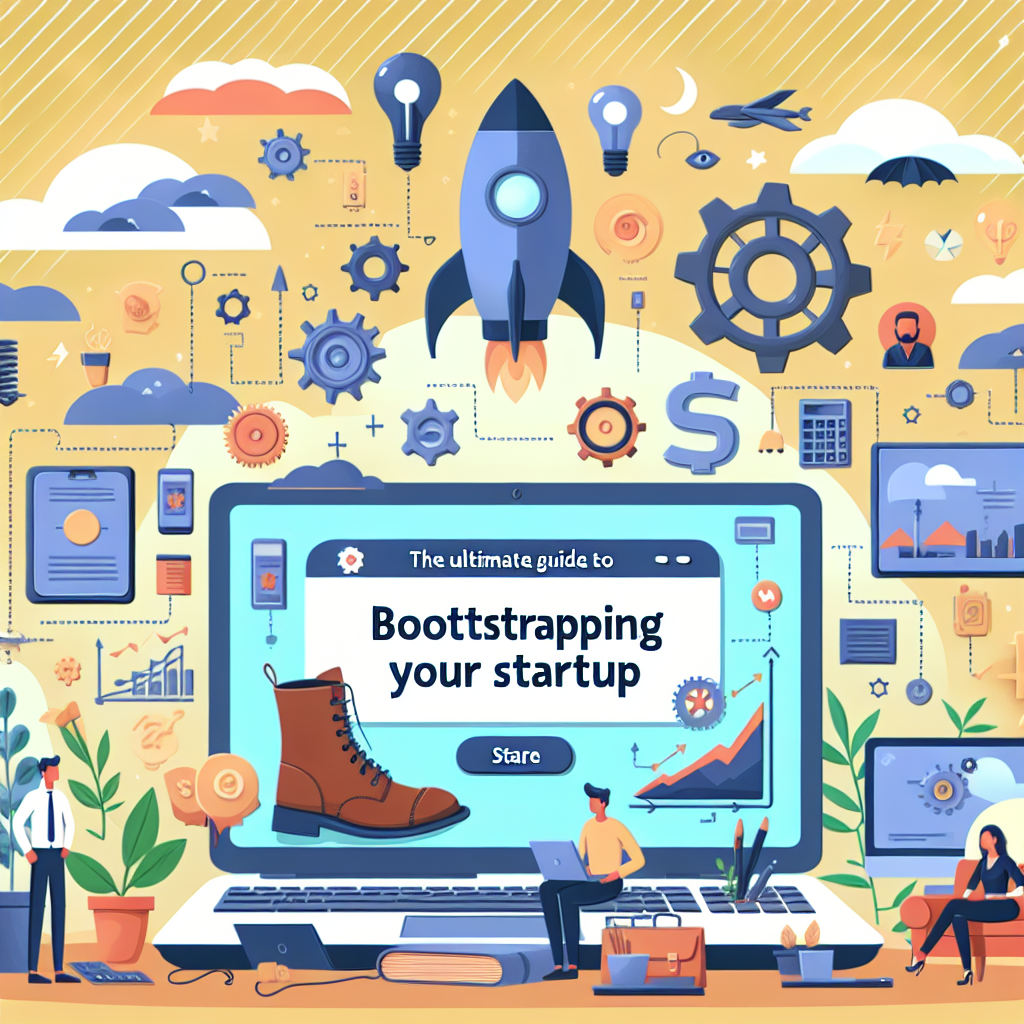
The Benefits of Bootstrapping Your Startup: Why It’s Worth Considering
Starting a business can be an exciting and daunting experience. As an entrepreneur, you have a vision and a passion for your idea, but you also have limited resources. This is where bootstrapping comes in. Bootstrapping is a term used to describe starting a business with minimal external funding. It involves using your own resources, such as personal savings, credit cards, and revenue from the business, to get your startup off the ground. In this article, we will explore the benefits of bootstrapping your startup and why it’s worth considering.
One of the main benefits of bootstrapping your startup is that it allows you to maintain control over your business. When you rely on external funding, you often have to give up a portion of your company in exchange for the investment. This means that you may have to answer to investors and make decisions that align with their interests, rather than your own. Bootstrapping, on the other hand, allows you to have complete control over your business and make decisions that are in line with your vision and goals.
Bootstrapping also forces you to be resourceful and creative with your limited funds. When you have a limited budget, you have to find ways to make the most out of every dollar. This can lead to innovative solutions and cost-saving measures that can benefit your business in the long run. It also teaches you to be more frugal and prioritize your spending, which can be a valuable skill for any entrepreneur.
Another benefit of bootstrapping is that it allows you to maintain a lean and agile business model. When you have limited resources, you have to be strategic about where you allocate your funds. This means focusing on the most essential aspects of your business and avoiding unnecessary expenses. By keeping your business lean, you can adapt quickly to changes in the market and pivot your strategy if needed. This flexibility can be a significant advantage, especially in the early stages of your startup.
Bootstrapping also allows you to build a strong foundation for your business. When you rely on external funding, there is a risk of becoming too dependent on that money. This can lead to overspending and a lack of financial discipline. Bootstrapping, on the other hand, forces you to be more cautious with your spending and focus on building a sustainable business model. By starting small and growing your business organically, you can ensure that your business is built on a solid foundation and has a higher chance of long-term success.
In addition to these benefits, bootstrapping also allows you to retain ownership of your business. As your business grows and becomes more successful, you will have the option to seek external funding or take on investors. However, by bootstrapping in the early stages, you can retain a larger percentage of your company and have more control over its direction and growth.
Of course, bootstrapping your startup also comes with its challenges. It requires a lot of hard work, dedication, and sacrifice. You may have to take on multiple roles and work long hours to keep your business afloat. However, these challenges can also be seen as opportunities for personal and professional growth. By taking on different roles and responsibilities, you can gain a better understanding of your business and develop new skills that can benefit you in the long run.
In conclusion, bootstrapping your startup can have many benefits, including maintaining control, being resourceful, staying lean and agile, building a strong foundation, and retaining ownership. While it may not be the easiest path, it can be a rewarding one that sets your business up for long-term success. So if you’re considering starting a business, don’t overlook the option of bootstrapping. It may just be the key to turning your vision into a successful reality.
Maximizing Limited Resources: Tips for Bootstrapping Your Startup
Starting a business can be an exciting and daunting experience. As an entrepreneur, you have a vision and a passion for your idea, but you may also face the challenge of limited resources. This is where bootstrapping comes in – a term used to describe starting and growing a business with minimal external funding. Bootstrapping requires creativity, resourcefulness, and a willingness to do more with less. In this article, we will provide you with the ultimate guide to bootstrapping your startup, so you can maximize your limited resources and turn your dream into a successful reality.
The first step in bootstrapping your startup is to have a clear understanding of your business idea and its potential. This means conducting thorough market research and identifying your target audience. By understanding your customers’ needs and preferences, you can tailor your product or service to meet their demands, which will ultimately lead to higher sales and revenue. Additionally, having a solid understanding of your market will help you make informed decisions when it comes to allocating your limited resources.
One of the key aspects of bootstrapping is to keep your costs low. This means being frugal and finding ways to save money wherever possible. For example, instead of renting an expensive office space, consider working from home or a co-working space. This will not only save you money on rent but also on utilities and other office expenses. You can also save money by using free or low-cost tools and software for tasks such as accounting, project management, and marketing.
Another way to maximize your limited resources is to leverage your network. As a startup, you may not have a large budget for hiring employees, so consider reaching out to your network for help. This could include friends, family, or former colleagues who may be willing to lend a hand in exchange for equity or a small fee. You can also tap into your network for potential partnerships or collaborations, which can help you reach a wider audience and save on marketing costs.
In addition to leveraging your network, you can also look for alternative sources of funding. This could include crowdfunding, where you can raise money from a large number of people who believe in your idea. You can also consider applying for grants or loans specifically designed for startups. These options may require more effort and time, but they can provide you with the necessary funds to grow your business without giving up equity.
As a bootstrapped startup, it is crucial to prioritize your expenses. This means focusing on the essentials and cutting back on non-essential expenses. For example, instead of spending money on fancy office furniture, invest in essential equipment and tools that will help you run your business efficiently. You should also keep a close eye on your cash flow and avoid unnecessary expenses that can drain your resources.
Another important aspect of bootstrapping is to be open to learning and adapting. As a startup, you may face challenges and setbacks, but it is essential to learn from them and adapt your strategies accordingly. This could mean pivoting your business model, changing your target audience, or finding new ways to generate revenue. By being open to learning and adapting, you can make the most out of your limited resources and increase your chances of success.
In conclusion, bootstrapping your startup requires a combination of creativity, resourcefulness, and a willingness to learn and adapt. By understanding your market, keeping your costs low, leveraging your network, and prioritizing your expenses, you can maximize your limited resources and turn your startup into a successful and sustainable business. Remember, Rome wasn’t built in a day, and neither will your business. Stay focused, stay determined, and keep bootstrapping!
From Idea to Launch: A Step-by-Step Guide to Bootstrapping Your Startup
Starting a business can be an exciting and daunting journey. You have a great idea, but you may not have the financial resources to bring it to life. This is where bootstrapping comes in. Bootstrapping is the process of starting and growing a business with little to no external funding. It requires a lot of hard work, determination, and creativity, but it can be a rewarding and successful way to launch your startup. In this article, we will guide you through the steps of bootstrapping your startup, from idea to launch.
Step 1: Validate Your Idea
The first step in bootstrapping your startup is to validate your idea. This means doing market research to determine if there is a demand for your product or service. You can start by talking to potential customers, conducting surveys, and analyzing your competition. This will help you understand your target market and ensure that your idea has the potential to be successful.
Step 2: Create a Business Plan
Once you have validated your idea, it’s time to create a business plan. This will serve as a roadmap for your startup and help you stay focused on your goals. Your business plan should include your mission and vision, target market, marketing strategy, financial projections, and any other important details about your business. It will also be essential when seeking funding in the future.
Step 3: Utilize Your Network
One of the biggest advantages of bootstrapping is that you can rely on your network for support. Reach out to friends, family, and colleagues who may be able to offer their skills, expertise, or resources to help you get your business off the ground. This can include anything from graphic design to legal advice. Don’t be afraid to ask for help – you never know who may be willing to lend a hand.
Step 4: Keep Costs Low
Bootstrapping requires you to be frugal and keep costs as low as possible. This means finding ways to save money on everything from office space to marketing. Consider working from home, using free or low-cost marketing strategies such as social media, and negotiating with suppliers for better deals. Every penny saved can be reinvested into your business.
Step 5: Prioritize Revenue
In the early stages of bootstrapping, your focus should be on generating revenue. This means finding ways to make money from your product or service as soon as possible. You can offer pre-sales, discounts, or even a minimum viable product to start bringing in revenue. This will not only help you cover your expenses but also show potential investors that your business has the potential to be profitable.
Step 6: Be Resourceful
Bootstrapping requires you to be resourceful and think outside the box. This may mean finding alternative ways to get things done, such as bartering services with other businesses or using free tools and resources available online. Don’t be afraid to get creative and find solutions that work for your business.
Step 7: Focus on Customer Satisfaction
In the early stages of bootstrapping, your customers are your biggest asset. Focus on providing excellent customer service and building strong relationships with your customers. This will not only help you retain customers but also attract new ones through word-of-mouth recommendations.
Step 8: Reinvest Profits
As your business starts to generate revenue, it’s important to reinvest those profits back into your business. This will help you grow and expand your business without relying on external funding. You can use the profits to improve your product or service, hire employees, or invest in marketing to reach a wider audience.
Step 9: Stay Committed
Bootstrapping is not an easy journey, and there will be challenges along the way. It’s important to stay committed and focused on your goals. Remember why you started your business in the first place and keep pushing forward. With hard work and determination, your business will continue to grow and thrive.
In conclusion, bootstrapping your startup may not be the easiest path, but it can be a rewarding and successful one. By validating your idea, creating a solid business plan, utilizing your network, keeping costs low, prioritizing revenue, being resourceful, focusing on customer satisfaction, reinvesting profits, and staying committed, you can turn your idea into a successful and sustainable business. So, roll up your sleeves and get ready to bootstrap your way to success!
Bootstrapping Success Stories: How These Startups Made It Without Outside Funding
Starting a business can be an exciting and daunting journey. One of the biggest challenges for entrepreneurs is securing funding to get their startup off the ground. However, there is a growing trend of startups that have successfully launched and grown without any outside funding. This method is known as bootstrapping, and it has become a popular option for many entrepreneurs. In this article, we will explore the concept of bootstrapping and share some inspiring success stories of startups that have made it without any external funding.
So, what exactly is bootstrapping? In simple terms, it means starting and growing a business with little to no external capital. This can include using personal savings, revenue from early sales, or even borrowing money from friends and family. Bootstrapping requires a lot of hard work, determination, and creativity, but it can also lead to great success.
One of the most well-known examples of bootstrapping success is the story of Airbnb. The founders, Brian Chesky and Joe Gebbia, were struggling to pay their rent when they came up with the idea of renting out air mattresses in their apartment to attendees of a design conference. This idea eventually evolved into the now multi-billion dollar company, Airbnb. The founders used their own savings to launch the business and even sold collectible cereal boxes to raise additional funds. Today, Airbnb is a household name and a prime example of how bootstrapping can lead to incredible success.
Another inspiring bootstrapping success story is that of Mailchimp. The email marketing platform was founded by Ben Chestnut and Dan Kurzius in 2001. They started the business with just $1,200 and operated out of a small apartment. The founders focused on providing a quality product and relied on word-of-mouth marketing to grow their customer base. Today, Mailchimp has over 15 million users and generates over $700 million in annual revenue. The company has remained independent and has not taken any outside funding, making it a true bootstrapping success.
Bootstrapping is not limited to tech startups. The popular ice cream brand, Ben & Jerry’s, also started as a bootstrapped business. The founders, Ben Cohen and Jerry Greenfield, used a $5 correspondence course on ice cream making to launch their business in 1978. They started with a small investment of $12,000 and grew the business by selling their ice cream out of a renovated gas station. Today, Ben & Jerry’s is a household name and a successful example of how bootstrapping can lead to long-term success.
One of the key benefits of bootstrapping is that it allows entrepreneurs to maintain control over their business. When external funding is involved, investors often have a say in the direction and decisions of the company. Bootstrapping allows entrepreneurs to make decisions based on their own vision and goals, without any outside influence. This can be a crucial factor in the success of a startup, as it allows for more flexibility and creativity.
Bootstrapping also forces entrepreneurs to be resourceful and think outside the box. Without a large budget, startups have to find creative ways to market their products or services and keep costs low. This can lead to innovative solutions and a strong sense of resilience within the team.
In conclusion, bootstrapping is a viable option for entrepreneurs who are looking to start and grow their business without external funding. It requires hard work, determination, and creativity, but it can lead to great success. The success stories of Airbnb, Mailchimp, and Ben & Jerry’s are just a few examples of how bootstrapping can lead to long-term success. So, if you have a great idea and the drive to make it happen, don’t let the lack of external funding hold you back. With bootstrapping, anything is possible.
Avoiding Common Pitfalls: Mistakes to Watch Out for When Bootstrapping Your Startup
Starting a business can be an exciting and daunting experience. As an entrepreneur, you have a vision and a passion for your idea, but you may not have the financial resources to bring it to life. This is where bootstrapping comes in. Bootstrapping is a term used to describe starting a business with little to no external funding. It requires a lot of hard work, determination, and creativity, but it can also be a rewarding and cost-effective way to launch your startup. However, like any other business venture, there are common pitfalls that you should be aware of when bootstrapping your startup. In this article, we will discuss some of these mistakes and how to avoid them.
The first mistake to watch out for when bootstrapping your startup is overspending. When you have limited resources, it can be tempting to spend money on things that are not essential for your business. This could include fancy office space, expensive equipment, or unnecessary marketing campaigns. While these things may seem important, they can quickly drain your funds and leave you with little to invest in the growth of your business. Instead, focus on the essentials and be frugal with your spending. Look for cost-effective alternatives and prioritize your expenses based on what will bring the most value to your business.
Another common pitfall is not having a clear business plan. Bootstrapping requires a lot of improvisation and flexibility, but that does not mean you should not have a solid plan in place. A business plan will help you stay focused and make informed decisions about your business. It should include your goals, target market, marketing strategies, and financial projections. Without a clear plan, you may find yourself lost and making decisions that are not in the best interest of your business. Take the time to create a detailed business plan and refer to it regularly to stay on track.
One mistake that many bootstrapped startups make is not investing in their team. As a founder, you may be tempted to do everything yourself to save money. However, this can quickly lead to burnout and a decline in the quality of your work. It is essential to invest in a team that shares your vision and can help you achieve your goals. This could include hiring freelancers, interns, or partnering with other businesses. By delegating tasks and working with others, you can focus on the core aspects of your business and ensure its success.
Another pitfall to avoid is not having a backup plan. Bootstrapping can be a risky endeavor, and things may not always go as planned. It is crucial to have a backup plan in case of unexpected challenges or setbacks. This could include having a side hustle to generate additional income or having a contingency fund to cover unexpected expenses. By having a backup plan, you can mitigate risks and keep your business afloat during tough times.
Lastly, one of the most common mistakes when bootstrapping is not seeking help or advice. As an entrepreneur, it can be tempting to do everything on your own and be in control of every aspect of your business. However, seeking advice from mentors, networking with other entrepreneurs, and joining startup communities can provide valuable insights and support. These resources can also help you avoid costly mistakes and provide guidance on how to grow your business.
In conclusion, bootstrapping your startup can be a challenging but rewarding experience. By avoiding these common pitfalls, you can increase your chances of success and build a sustainable business. Remember to be frugal with your spending, have a clear business plan, invest in your team, have a backup plan, and seek advice when needed. With determination, hard work, and smart decision-making, you can turn your bootstrapped startup into a thriving business.
Vi har mång spännande event inom Entreprenörskap, Investering och Personlig Utveckling. Du kan se alla här:
www.swedishwealthinstitute.se/event




